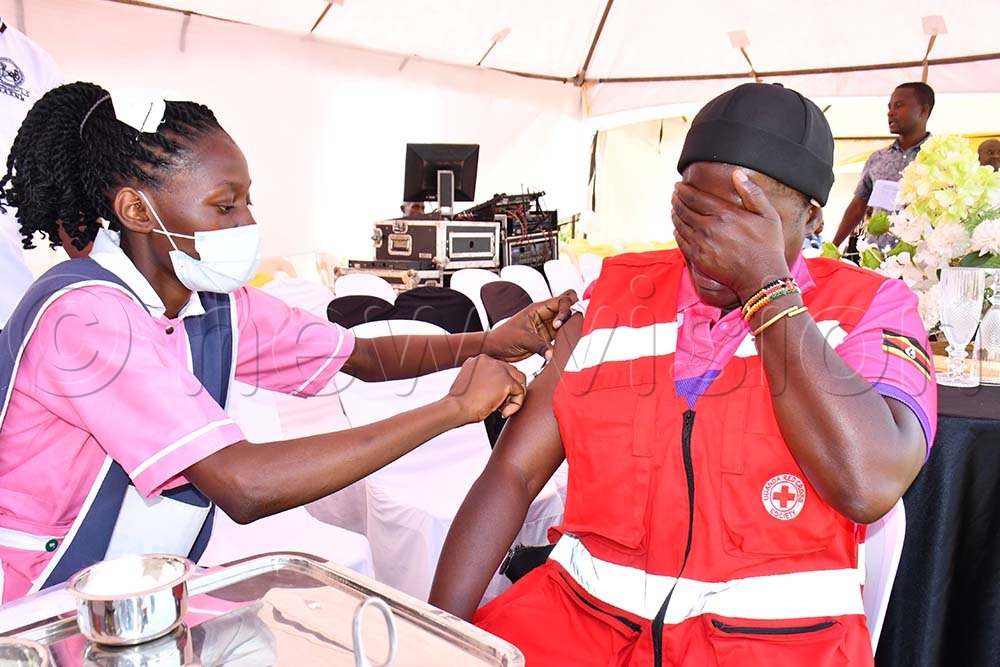Uganda launches Yellow Fever vaccination campaign for 17 districts
Vaccination centres have been set up at different health facilities in these districts, and for "hard to reach" areas, health workers will move to those designated areas to vaccinate people after mobilisation by leaders.
A nurse vaccinates Meddie Mukalu (right), the Iganga Municipality MP hopeful, during the launch of the third phase of the National Yellow Fever Preventive mass vaccination campaign at Iganga district headquarters ground on September 30th. (Credit: Donald Kiirya)
IGANGA - The Ministry of Health has launched the third and final phase of the Yellow Fever Preventive mass vaccination campaign, targeting five million individuals across 17 districts in the Mubende and Busoga sub-regions.
The launch of phase three B, held at Iganga district ground on September 30th under the theme "One Injection—Lifelong Protection—Eliminate Yellow Fever Epidemics by 2026", was attended by officials from the Ministry of Health, UNICEF, WHO and district officials, among others.
As Uganda moves closer to its vision of a healthy, developed nation by 2040, this campaign marks a significant step toward eliminating yellow fever.
Dr. Alfred Driwale, the Commissioner of Health Services in charge of Institutional Capacity Building and Health Workforce Development, represented the Minister of Health Dr. Ruth Aceng Ocero.
The campaign, running from September 30th, 2025, to October 6th, 2025, aims to vaccinate all eligible individuals aged 1 to 60 years, reinforcing Uganda’s commitment to eliminating yellow fever epidemics.
It will be conducted in ten districts of Busoga sub-region and seven districts in Mubende region. Districts in Busoga sub-region include Jinja, Namayingo, Iganga, Buyende, Mayuge, Bugiri, Bugweri, Luuka, Kamuli and Jinja City.
Districts in Mubende sub-region include Kasanda, Kisuge, Kyankwanzi, Mityana, Mubende, Nakaseke and Nakasongola.
Dr. Driwale emphasised the critical role of community engagement and accountability in ensuring the campaign’s success.
He urged local leaders, health workers, and community members to mobilise effectively to achieve 100% vaccination coverage.
He revealed that the campaign is supported by partners including GAVI, WHO, UNICEF and civil society organisations, with over 5 million vaccine doses allocated for this phase.
“The vaccine is now part of our routine immunisation programme, so that by the time the child gets to nine months old, he/she get yellow fever vaccination,” Driwale said.
Vaccination centres have been set up at different health facilities in these districts, and for "hard to reach" areas, health workers will move to those designated areas to vaccinate people after mobilisation by leaders. 
A nurse vaccinates Angel Kagoya (right), a Red Cross staff member, during the launch of the third phase of the National Yellow Fever Preventive mass vaccination campaign at Iganga district headquarters ground on September 30th. (Credit: Donald Kiirya)
The Assistant Commissioner of Health Promotion and Strategic Health Communication in the Ministry of Health, Dr. Ronald Miria Ocaatre, highlighted the disease’s impact, noting its similarity to malaria symptoms but with potentially fatal consequences if untreated.
He added that the campaign builds on previous phases that have successfully vaccinated over 25 million Ugandans since 2022.
Dr. Miria recounted a poignant example from a local drama performance, illustrating how resistance to vaccination can lead to tragic outcomes, such as the loss of a child.
Dr. Michael Baganizi, the Assistant Commissioner for Vaccines and Immunisation at the Ministry of Health, underscored the importance of this final phase, noting that it targets the remaining 17 districts to complete nationwide coverage.
“After this, yellow fever vaccination will be integrated into routine immunisation for children at nine months, alongside the measles vaccine,” Dr. Baganizi explained.
He also highlighted the vaccine’s importance for international travellers, as proof of vaccination is mandatory for those entering or leaving Uganda.
The government provides the vaccine free of charge, with only a nominal fee of 10,000 shillings for a travel card at regional referral hospitals.
Dr. Annet Kisakye, the National Professional Officer for Vaccine-Preventable Diseases at the World Health Organisation (WHO), congratulated Uganda for its leadership in protecting over 26 million citizens to date, to reach 31 million by the campaign’s end.
Representing the United Nations, she emphasised the global strategy to eliminate yellow fever epidemics, known as the EYE (Eliminate Yellow Fever Epidemics) strategy.
“For every 100 eligible people, we need 90 vaccinated to achieve our goal of preventing outbreaks,” Dr. Kisakye said, reassuring the public that the vaccine is safe, effective, and offers lifelong protection with a single dose.
The vaccination drive will take place at health facilities, schools, markets, and designated outreach posts, ensuring accessibility across the targeted regions.
The campaign is supported by partners including GAVI, WHO, UNICEF, and civil society organisations, with over 5 million vaccine doses allocated for this phase.
Yellow fever, a mosquito-borne viral disease that can cause severe liver damage and jaundice, remains a significant public health threat in Uganda, one of 27 high-risk countries globally.
Present at the event were District Health Officers from the districts in Busoga sub-region, students from various nursing schools, cultural leaders and local leaders.